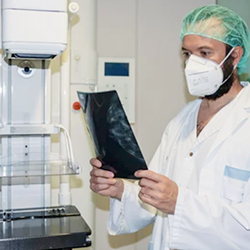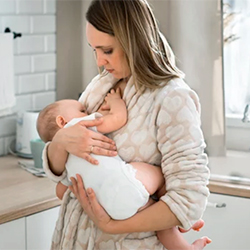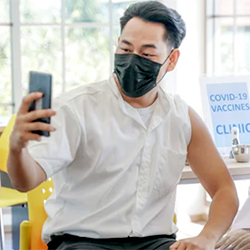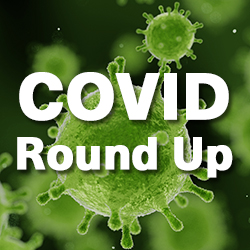By Marie Rosenthal, MS
A program during the pandemic that provided mammogram results before patients left the imaging center resulted in faster diagnosis and reduced disparities. U.S. hospital data showed, once again, that the mRNA COVID-19 vaccines are highly effective at preventing hospitalizations, emergency department visits and ICU admissions due to the virus. Another vaccine study found them safe and effective for breastfeeding mothers and infants. Monoclonal antibodies, the only FDA-authorized outpatient treatment for patients with symp-tomatic COVID-19, are underused. And researchers wonder whether selfies can be used to fight the pandemic.
Faster Diagnoses Found From Same-Day Mammogram Readings During COVID-19
Providing results about a mammogram before the patient leaves the imaging center can speed the diagnosis of cancer and reduce disparities in care, according to new research (AJR Am J Roentgenol 2021 Sep 8. doi:10.2214/AJR.21.26597 https://www.ajronline.org/doi/10.2214/AJR.21.26597).

In May 2020, Brian N. Dontchos, MD, of Massachusetts General Hospital and Harvard Medical School, in Boston, implemented a program where a dedicated breast imaging radiologist interpreted all screening mammograms in real time, with patients receiving their results before being discharged. A separate radiologist made efforts to perform any recommended diagnostic imaging during the same visit. The team then retro-spectively identified screening mammograms performed from June 1 to Oct. 31, 2019 (pre-implementation; 8,222 examinations) or June 1 to Oct. 31, 2020 (post-implementation; 7,235 examinations). They found that 521 and 359 patients had abnormal screening examinations, respectively.
“The immediate-read screening mammography program reduced prior racial and ethnic disparities in same-day diagnostic imaging after abnormal screening mammograms,” the radiologists wrote.
Before implementing this immediate-read screening mammography program, minorities had lower odds than white patients of having same-day diagnostic imaging after abnormal screening examinations (adjusted odds ratio [OR], 0.30; 95% CI, 0.10-0.86; P=0.03). After implementation, these odds were not significantly different (OR, 0.92; 95% CI, 0.50-1.71; P=0.80), according to the radiologists.
Responding to the Society of Breast Imaging’s recommendation to reduce patient hospital visits during COVID-19, “we believe the practice is sustainable and not limited to only a transient period of lower-than-normal screening volumes,” the authors noted.
—The authors are supported by institutional grant funding from GE Healthcare Inc. and from Hologic.
COVID-19 Vaccines Highly Effective in Preventing Hospitalizations, ER Visits
Data from nearly 200 U.S. hospitals demonstrated that two-dose COVID-19 vaccinations are highly effective at preventing hospitalizations, emergency department (ED) visits and ICU admissions due to the virus (N Engl J Med 2021 Sep 8. doi:10.1056/NEJMoa2110362).
The real-world evidence gathered from electronic health records (EHRs) between January and June 2021 showed that the vaccines provide high levels of protection for populations disproportionately affected by the virus, including older adults and minorities.
The CDC collaborated with six U.S. health care systems plus the Regenstrief Institute, to create the VISION network to assess COVID-19 vaccine effectiveness. Regenstrief, Columbia University Irving Medical Center, HealthPartners, Intermountain Healthcare, Kaiser Permanente Northern California, Kaiser Permanente Northwest and University of Colorado all contributed hospitalization and ICU data for patients older than 50 years of age from a total of 187 hospitals, in addition to data from EDs and urgent care clinics. The data covered 45,000 medical encounters.
Data analysis showed two-dose messenger RNA (mRNA) vaccination (Moderna and Pfizer-BioNTech) was:
- 89% effective at preventing COVID-19 hospitalizations;
- 91% effective at preventing COVID-19 ED or urgent care visits; and
- 90% effective at preventing COVID-19 ICU admissions.
The effectiveness was significantly lower in individuals who received only the first dose of the two-shot vaccination.
The vaccines “offer significant protections for people older than 85, people with chronic medical conditions as well as Black and Hispanic adults. All are groups who have been hit particularly hard by this disease. We hope this information will convince more people to get vaccinated to protect not only themselves but their community,” said Mark Thompson, PhD, a member of the CDC COVID-19 Rapid Response Team.
This study was also one of the first to look at the effectiveness of the single-dose Johnson & Johnson vaccine. It was found to be 73% effective against ED and urgent care visits, and 68% against hospitalizations. However, the authors noted the smaller sample size may affect the precision of these estimates and state that more data are needed.
“This real-world evidence corroborates the results of clinical trials and provides even more confidence in the vaccines,” said co-author Shaun Grannis, MD, MS, the vice president for data and analytics at Regenstrief and a professor of family medicine at Indiana University School of Medicine, in Indianapolis. “This study is an excellent example of how EHR data can be leveraged for public health, and how collaboration between health entities can provide new and beneficial insights.”
No Serious COVID-19 Vaccine Side Effects in Breastfeeding Moms, Infants
Researchers found after Moderna and Pfizer-BioNTech COVID-19 vaccination, breastfeeding mothers experi-enced similar side effects as non-breastfeeding women, and infants exhibited no serious side effects (Breast-feed Med 2021 Aug 31. doi:10.1089/bfm.2021.0169).

Although both mRNA vaccines for SARS-CoV-2 received emergency use authorization from the FDA in De-cember, the early trials excluded lactating women, leading to questions about their safety in this specific population. (The Pfizer-BioNTech vaccine has since received full approval.)
“A mother’s first concern is the safety of her child,” said Christina Chambers, PhD, MPH, a professor of pedi-atrics at University of California San Diego School of Medicine and professor in the Herbert Wertheim School of Public Health and Human Longevity Science, UC San Diego. “Our study, along with previous research, sug-gests the Pfizer and Moderna vaccines are not red flags for breastfeeding mothers and their infants.”
The results found that more than 85% of the 180 breastfeeding women in the study who received an mRNA COVID-19 vaccine reported temporary localized symptoms, such as pain, redness, swelling or itching at the injection site, and systemic side effects, including chills, muscle/body aches, fever and vomiting, with higher frequency following the second dose.
In addition, following the second dose of vaccine, women who received the Moderna brand were signifi-cantly more likely to report symptoms. A small proportion of women following the first dose of either vaccine brand reported a reduction in milk supply, and significantly more women reported a reduction in milk sup-ply following the second dose of Moderna.
“We want to emphasize that the reduction in milk supply was in a small subset of women and came back fully within 72 hours after vaccination. We also cannot be certain that the supply reduction was a side effect of the vaccine or another unknown factor,” Dr. Chambers said. “What we do know is that the vaccine is incred-ibly effective in providing protection from COVID-19, which has proven to be a devastating and serious virus with possible long-term side effects.”
Irritability and poor sleep were reported in some breastfed children, but no serious adverse events.
“We know the many benefits of breastfeeding. Breast milk provides an abundance of nutritional compo-nents to infants that provide many health benefits, from stronger immune systems to lower rates of obesity and other conditions and illnesses,” Dr. Chambers said.
“Our results should encourage lactating women to get the COVID-19 vaccine and to continue to breastfeed their infants. They do not have to choose one over the other. Both are critical.”
Low Uptake of FDA-Authorized mAb Treatments for COVID-19
Eighteen months into the pandemic, monoclonal antibodies (mAbs) remain the only FDA-authorized outpatient treatment for patients with symptomatic COVID-19. Laboratory-made proteins that mimic the immune system’s ability to target and block the virus that causes COVID-19 from infecting human cells, mAbs have been shown to reduce the risk for the most severe symptoms of COVID-19 and of being ad-mitted to the hospital. While the federal government has distributed over 1 million antibody treatments to states, prior anecdotal reports suggested they may have been underused.
They were correct, according to a new analysis by a team of clinician-researchers at Beth Israel Deaconess Medical Center? (J Gen Intern Med 2021 Sep 8. doi:10.1007/s11606-021-07109-5).
The team examined outpatient medical claims from a national database covering more than 200 million U.S. patients between November 2020 (when mAbs were granted emergency use authorization by the FDA) and April 2021.
“During our study period, more than 20 million Americans were diagnosed with COVID-19, yet we found that fewer than 70,000 patients received monoclonal antibody treatments out of a study base encompassing over 60% of Americans,” said corresponding author Timothy S. Anderson, MD, MAS, a clinician-investigator and an assistant professor medicine in the Division of General Medicine at Beth Israel., in Boston “These med-ications were authorized on the cusp of the largest surge of COVID-19 hospitalizations and the initial stages of vaccine rollout, so health systems may not have had the capacity to launch monoclonal antibody clinics im-mediately. However, we expected to see continued growth in their use over time and were surprised to find a sharp decline in monoclonal antibody use throughout early 2021.”
Although additional research is needed to explore the factors that may have contributed to the low initial uptake of mAbs, Dr. Anderson and his colleagues speculated that they may include stockpiling of allocated treatments; limited distribution by health systems; barriers to patient access to treatments that require IV infusion; or hesitancy to adopt new treatments by providers and/or patients.
The researchers also observed demographic and insurer differences in antibody use that suggest possible disparities in access; for example, while Medicare recipients made up 10% of the research population, they comprised only 3% of patients who received mAbs.
“Many patients receive COVID-19 testing through school, workplace and sites outside the health care system, and these sites may not be equipped to refer patients to receive monoclonal antibody treatments, partic-ularly if patients do not already have an existing relationship with a health care provider,” Dr. Anderson explained.
The study was conducted through the use of insurance claims data from the COVID-19 Research Database Consortium, which covers 200 million adults but does not capture treatments administered to other patients, including those receiving care through the Department of Veterans Affairs and other federal health settings, or treatments provided free of charge.
Can That Selfie Fight the Pandemic?
As COVID-19 vaccinations began in December 2020, social media and online platforms were awash with celebrities, health care workers, politicians and eventually laypeople sharing selfies confirming they got the shot.
At the same time, vaccination opponents continued to use social media to present arguments and misinformation on vaccines’ safety and efficacy. A group of scholars from the University of Kansas published a com-mentary article arguing that vaccine selfies, when done properly, can be an effective and ethical way to fight the pandemic, misinformation and share positive experiences (Psychol Health 2021 Aug 2. doi:10.1080/08870446.2021.1957888).

Humans are a naturally social species and tend to do what they observe the majority of others doing, the theory of normative conduct holds. Social media is a platform in which people share their behavior and reac-tions to everything from dining to sports, politics to health. While it has received no shortage of criticism, social media also can be a positive factor, researchers said, including in showing others they are vaccinated, ready to return to social norms and more.
“Social media is often the catalyst, or viewed as where misinformation on vaccines is coming from. We wanted to look at the positive side as well and how it has been used to help,” said co-author Mauryne Abwao, a doctoral student in journalism and mass communications at the University of Kansas, in Lawrence. “When we first saw these selfies appearing, we thought it could be the foundation of more study of social media for good.”
Vaccine selfies have created a bandwagon effect in encouraging others to join them in getting the shots. Those posting such selfies have several key motives: to indicate to others they are vaccinated; to invite loved ones and social contacts to have gatherings again after pandemic-induced quarantines; to encourage those skeptical to get vaccinated; and to share their personal stories about the effects of the vaccine.
The authors wrote that there has been debate about whether sharing vaccine selfies constitutes shaming of those who have not been vaccinated, but argued the practice is one of the most prolific ways to share that the vaccines are safe and effective. Similarly, there have been criticisms that the practice of taking photos while receiving a shot can slow down the process or interfere with health care workers, or that posting a photo of one’s vaccination card can subject that individual to identity theft or compromised personal information.
To that end, the authors made several suggestions on sharing effective vaccine selfies, including a well-lit photo that shows a person’s face and arm. Such a photo, accompanied with clear text that indicates what vac-cine dose the person received—such as Johnson & Johnson, Moderna or Pfizer-BioNTech—along with hashtags such as #IGotTheShot, #BeatTheVirus or #vaccineswork, can encourage others who may be hesitant to take part.
“We’ve seen many times social media as a place where trends are set, especially with people mimicking be-havior. It’s much like fashion. Everybody wants to have the latest. It doesn’t matter when you got it. People in many places around the world are still excited and posting these selfies. The conversation will be relevant for a long time,” Ms. Abwao said.


